C
属性动画 QML 类型
动画化属性值的变化。 更多信息...
| 导入语句 | import QtQuick |
| 自 | Qt Quick Ultralite 1.0 |
| 继承自 | |
| 被以下所继承 |
属性
- duration : int
- easing
- easing.bezierCurve : list
- easing.type : 枚举
- easing.bezierCurve : list
- from : variant
- properties : string
- property : string
- target : Object
- to : variant
详细描述
PropertyAnimation 提供了动画化属性值变化的途径。
它可以以多种方式定义动画
- 在 Transition 中
例如,使用
InOutQuad缓动曲线动画化任何因状态改变而改变其x或y属性的对象Item { id: root Rectangle { id: rect width: 100; height: 100 color: "red" } states: State { name: "moved" PropertyChanges { target: rect; x: 50 } } transitions: Transition { PropertyAnimation { properties: "x,y"; easing.type: Easing.InOutQuad } } }
- 在 Behavior 中
例如,动画化矩形的所有
x属性的改变Rectangle { width: 100; height: 100 color: "red" Behavior on x { PropertyAnimation {} } MouseArea { anchors.fill: parent; onClicked: parent.x = 50 } }
- 作为属性值源
例如,反复动画化矩形的
x属性Rectangle { width: 100; height: 100 color: "red" SequentialAnimation on x { loops: Animation.Infinite PropertyAnimation { to: 50 } PropertyAnimation { to: 0 } } }
- 独立使用
例如,动画化矩形的
width属性 500ms,从当前宽度到 30Rectangle { id: theRect width: 100; height: 100 color: "red" // this is a standalone animation, it's not running by default PropertyAnimation { id: animation; target: theRect; property: "width"; to: 30; duration: 500 } MouseArea { anchors.fill: parent; onClicked: animation.running = true } }
根据动画的使用方式,通常使用的属性集会有所不同。有关更多信息,请参阅个别属性文档以及 动画和转换 简介。
请注意,PropertyAnimation 继承了抽象的 Animation 类型。这包括控制动画的额外属性和方法。
参见 动画和转换.
属性文档
这些属性用作一组来确定应该动画化哪些属性。单数和复数形式在功能上相同,例如
NumberAnimation { target: theItem; property: "x"; to: 500; }
与下面具有相同的意义
NumberAnimation {
targets theItem;
properties: "x";
to: 500;
}在许多情况下,这些属性不需要明确指定,因为它们可以从动画框架中推断出来
| 值源/行为 | 当动画用作值源或行为中时,默认的目标和动画的属性名称都可以被推断。Rectangle { id: theRect width: 100; height: 100 color: Qt.rgba(0,0,1) NumberAnimation on x { to: 500; loops: Animation.Infinite } //animate theRect's x property Behavior on y { NumberAnimation {} } //animate theRect's y property } |
| 过渡 | 在过渡中使用时,属性动画假定匹配所有目标但实际上没有属性。在实践中,这意味着您需要指定至少一个属性才能使动画执行任何动作。Rectangle { id: theRect width: 100; height: 100 color: Qt.rgba(0,0,1) Item { id: uselessItem } states: State { name: "state1" PropertyChanges { theRect { x: 200 y: 200 z: 4 } } PropertyChanges { uselessItem { x: 10 y: 10 z: 2 } } } transitions: Transition { //animate both theRect's and uselessItem's x and y to their final values NumberAnimation { properties: "x,y" } //animate theRect's z to its final value NumberAnimation { target: theRect; property: "z" } } } |
| 独立使用 | 当动画独立使用时,目标和属性都需要明确指定。Rectangle { id: theRect width: 100; height: 100 color: Qt.rgba(0,0,1) //need to explicitly specify target and property NumberAnimation { id: theAnim; target: theRect; property: "x"; to: 500 } MouseArea { anchors.fill: parent onClicked: theAnim.start() } } |
如上述示例所示,属性指定为要动画化的属性名称的逗号分隔字符串。
参见 动画和转换.
duration : int |
该属性包含动画的持续时间,单位为毫秒。
默认值是250。
指定动画使用的缓和曲线
要指定缓和曲线,至少需要指定类型。默认缓和曲线是 Easing.Linear。
PropertyAnimation { properties: "y"; easing.type: Easing.InOutSine; }
可用类型包括
Easing.Linear | 线性(t)函数的缓和曲线:速度恒定。 | 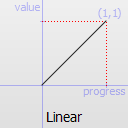 |
Easing.InQuad | 二次(t^2)函数的缓和曲线:从零速度加速。 | 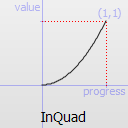 |
Easing.OutQuad | 二次(t^2)函数的缓和曲线:减速到零速度。 | 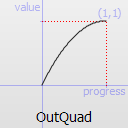 |
Easing.InOutQuad | 二次(t^2)函数的缓和曲线:加速到中点,然后减速。 | 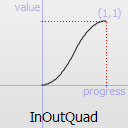 |
Easing.OutInQuad | 二次(t^2)函数的缓和曲线:减速到中点,然后加速。 | 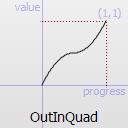 |
Easing.InCubic | 立方(t^3)函数的缓和曲线:从零速度加速。 |  |
Easing.OutCubic | 立方(t^3)函数的缓和曲线:减速到零速度。 | 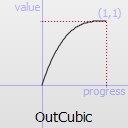 |
Easing.InOutCubic | 立方(t^3)函数的缓和曲线:加速到中点,然后减速。 | 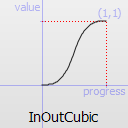 |
Easing.OutInCubic | 立方(t^3)函数的缓和曲线:减速到中点,然后加速。 | 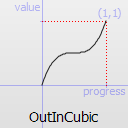 |
Easing.InQuart | 四次(t^4)函数的缓和曲线:从零速度加速。 | 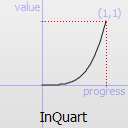 |
Easing.OutQuart | 四次(t^4)函数的缓和曲线:减速到零速度。 | 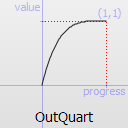 |
Easing.InOutQuart | 四次(t^4)函数的缓和曲线:加速到中点,然后减速。 | 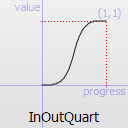 |
Easing.OutInQuart | 四次(t^4)函数的缓和曲线:减速到中点,然后加速。 |  |
Easing.InQuint | 五次(t^5)函数的缓和曲线:从零速度加速。 | 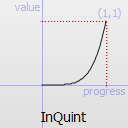 |
Easing.OutQuint | 五次(t^5)函数的缓和曲线:减速到零速度。 | 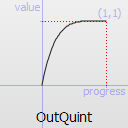 |
Easing.InOutQuint | 五次(t^5)函数的缓和曲线:加速到中点,然后减速。 | 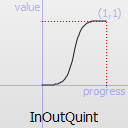 |
Easing.OutInQuint | 五次(t^5)函数的缓和曲线:减速到中点,然后加速。 | 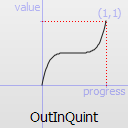 |
Easing.InSine | 正弦(sin(t))函数的缓和曲线:从零速度加速。 | 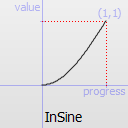 |
Easing.OutSine | 正弦(sin(t))函数的缓和曲线:减速到零速度。 | 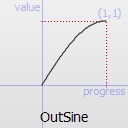 |
Easing.InOutSine | 正弦(sin(t))函数的缓和曲线:加速到中点,然后减速。 | 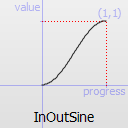 |
Easing.OutInSine | 正弦(sin(t))函数的缓和曲线:减速到中点,然后加速。 | 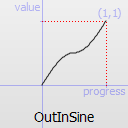 |
Easing.InExpo | 指数(2^t)函数的缓和曲线:从零速度加速。 |  |
Easing.OutExpo | 指数(2^t)函数的缓和曲线:减速到零速度。 | 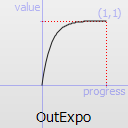 |
Easing.InOutExpo | 指数(2^t)函数的缓和曲线:加速到中点,然后减速。 | 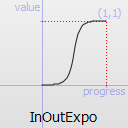 |
Easing.OutInExpo | 指数(2^t)函数的缓动曲线:减速直到 halfway,然后加速。 | 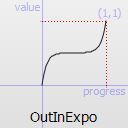 |
Easing.InCirc | 圆形(sqrt(1-t^2))函数的缓动曲线:从零速度开始加速。 |  |
Easing.OutCirc | 圆形(sqrt(1-t^2))函数的缓动曲线:减速到零速度。 | 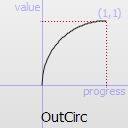 |
Easing.InOutCirc | 圆形(sqrt(1-t^2))函数的缓动曲线:加速直到 halfway,然后减速。 |  |
Easing.OutInCirc | 圆形(sqrt(1-t^2))函数的缓动曲线:减速直到 halfway,然后加速。 | 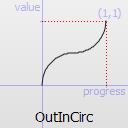 |
Easing.InElastic | 弹性(指数衰减正弦波)函数的缓动曲线:从零速度开始加速。它使用默认值,峰值振幅(1.0)和衰减周期(0.3)。 | 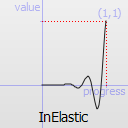 |
Easing.OutElastic | 弹性(指数衰减正弦波)函数的缓动曲线:减速到零速度。它使用默认值,峰值振幅(1.0)和衰减周期(0.3)。 | 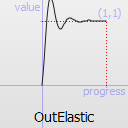 |
Easing.InOutElastic | 弹性(指数衰减正弦波)函数的缓动曲线:加速直到 halfway,然后减速。 | 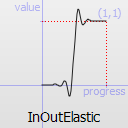 |
Easing.OutInElastic | 弹性(指数衰减正弦波)函数的缓动曲线:减速直到 halfway,然后加速。 | 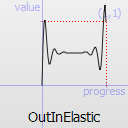 |
Easing.InBack | 后(超出三次函数:s*t^3 - s*t^2)缓动进入:从零速度开始加速。它使用默认值超出量(s: 1.70158)。 | 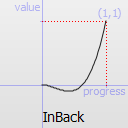 |
Easing.OutBack | 后(超出三次函数:s*t^3 - s*t^2)缓动退出:减速到零速度。它使用默认值超出量(s: 1.70158)。 | 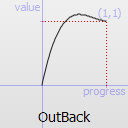 |
Easing.InOutBack | 后(超出三次函数:s*t^3 - s*t^2)缓动进出:加速直到 halfway,然后减速。它使用默认值超出量(s: 1.70158)。 | 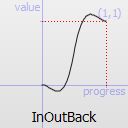 |
Easing.OutInBack | 后(超出三次缓动:s*t^3 - s*t^2)缓动出/入:减速直到 halfway,然后加速。它使用默认值超出量(s: 1.70158)。 |  |
Easing.InBounce | 弹跳(指数衰减抛物线弹跳)函数的缓动曲线:从零速度开始加速。 | 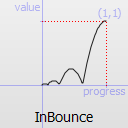 |
Easing.OutBounce | 弹跳(指数衰减抛物线弹跳)函数的缓动曲线:从零速度开始减速。 |  |
Easing.InOutBounce | 弹跳(指数衰减抛物线弹跳)函数缓动进出:加速直到 halfway,然后减速。 | 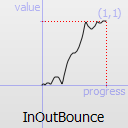 |
Easing.OutInBounce | 弹跳(指数衰减抛物线弹跳)函数缓动出/入:减速直到 halfway,然后加速。 | 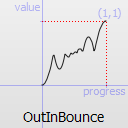 |
Easing.BezierSpline | 由 easing.bezierCurve 属性定义的自定义缓动曲线。 |
easing.bezierCurve 仅当 easing.type 是: Easing.BezierSpline 时适用。此属性是一个包含定义从 0,0 到 1,1 的曲线的三点组列表 <real> - 控制点1,控制点2,终点:[cx1, cy1, cx2, cy2, endx, endy, ...]。最后一个点必须是 1,1。
注意: 如果您设置了 easing.bezierCurve 但未指定 easing.type,则 qmltocpp 工具 将生成隐式地将 easing.type 设置为 Easing.BezierSpline 的代码。
from : variant |
此属性保存动画的起始值。
如果 PropertyAnimation 在一个 Transition 或 Behavior 中定义,则此值默认为 Transition 的初始状态中定义的值,或 Behavior 触发时的属性当前值。
参见 动画和转换.
在特定Qt许可证下可用。
了解更多。
